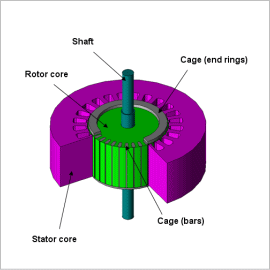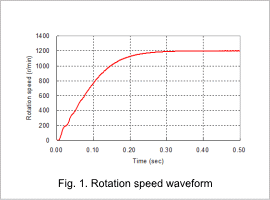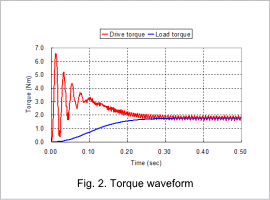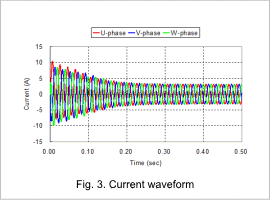*Please prepare a license ID and password for the license administrator.
*It is different from the service for JMAG WEB MEMBER (free membership). Please be careful.
Overview

The simplest method for starting an induction motor is a line start that connects the motor to a direct power supply. For a line start, the static impedance is small compared to impedance during rated operation, so a large current flows during the initial start-up.
The large current flowing through both the primary and secondary sides during start-up causes intense magnetic saturation near the induction motor’s gap. This magnetic saturation results in reduced impedance, so the starting current grows even larger. The size of the starting current affects the voltage source capacity connected to the induction motor, as well as both the electromagnetic force and heat capacity that operate on the motor’s coils. This is why it is beneficial to investigate the starting performance of an induction motor with the finite element method (FEM), which can account for local magnetic saturation.
This Application Note presents an analysis that simulates the line start of an induction motor and obtains the starting performance of its rotation speed variations.
The large current flowing through both the primary and secondary sides during start-up causes intense magnetic saturation near the induction motor’s gap. This magnetic saturation results in reduced impedance, so the starting current grows even larger. The size of the starting current affects the voltage source capacity connected to the induction motor, as well as both the electromagnetic force and heat capacity that operate on the motor’s coils. This is why it is beneficial to investigate the starting performance of an induction motor with the finite element method (FEM), which can account for local magnetic saturation.
This Application Note presents an analysis that simulates the line start of an induction motor and obtains the starting performance of its rotation speed variations.
Rotation Speed Waveform

The rotation speed waveform when starting the induction motor is indicted in fig. 1.
Fig. 1 shows that the motor accelerates rapidly at the initial start-up, and reaches a steady state at approximately 0.5 s.
Fig. 1 shows that the motor accelerates rapidly at the initial start-up, and reaches a steady state at approximately 0.5 s.
Torque waveform

The waveforms of the drive torque and load torque when starting the induction motor are indicated in fig. 2.
Fig. 2 shows that an extremely large drive torque is produced at the initial start-up. In a steady state, a drive torque that is almost constant is generated in order to achieve balance with the load torque.
Fig. 2 shows that an extremely large drive torque is produced at the initial start-up. In a steady state, a drive torque that is almost constant is generated in order to achieve balance with the load torque.
Current waveform

The current waveform of the stator coil when the induction motor starts is indicated in fig. 3.
Fig. 3 shows that an extremely large current is produced during the initial start-up. This is because the reverse voltage at initial start up is small and almost all of the power supply voltage is applied to the stator coils. At a steady state, the three-phase AC has an amplitude of less that 5 A.
Fig. 3 shows that an extremely large current is produced during the initial start-up. This is because the reverse voltage at initial start up is small and almost all of the power supply voltage is applied to the stator coils. At a steady state, the three-phase AC has an amplitude of less that 5 A.


